The Last Navigator
The Last Navigator is the inspiring story of Queenslander Gordon Goodwin DSO, a Royal Australian Air Force navigator who survived five years of dangerous service flying missions over north-west Europe, to become the Chief Navigator for Qantas in its pre-jet years.
READ REVIEW
↓
The Last Navigator
Paul Goodwin with Gordon Goodwin | July 2020
Gordon Goodwin began writing his memoirs utilising his Royal Australian Air Force (RAAF) logbook before his death in 2012. His amazing story was completed by his son Paul, with this tale having two voices. Its publication is timely, as we mark the twin 75th anniversaries of the end of the Second World War in Europe and the Pacific.
Gordon’s early life is covered in the first two chapters. The Great Depression decimated his parents’ farm at Montville on Queensland’s Sunshine Coast and stopped his schooling. His uncle Stan’s intervention in getting him a job in the Bundaberg sugar industry enabled him to qualify as a sugar chemist and look forward to a career. His experiences during the hard times in 1930s Australia may resonate with readers, who are now coping with our COVID-19 recession.
The Second World War changed Gordon’s plans. He joined the RAAF in October 1940 and initially trained at Bradfield Park, Sydney. In December, Gordon was shipped to Canada for specialist training under the Empire Air Training Scheme (EATS), where he was selected to become a navigator. In August 1941, he honed his new skills, ferrying a US ‘Lend-Lease’ Hudson bomber across the Atlantic to Britain. His personal recollections of the daily training schedules and aircraft characteristics are important, as these add a trainees’ perspective to the many studies that have primarily examined the EATS as a wartime measure.
Next, he underwent Royal Air Force operational training, before being allotted to the ‘slaughter pen’ that was Bomber Command, established in 1940 to bring the war to Germany. Inadequate aircraft with only small bomb loads and an emphasis on propaganda pamphlet drops made Bomber Command ineffectual. After Air Marshall Harris took over, larger planes and a new strategy saw the RAF target German industry. Gordon joined the new No. 260 Squadron RAAF in 1942. As part of a crew of six, he flew 31 missions in Vickers Wellingtons during his first tour. Gordon’s crew was the squadron’s first to survive a full tour.
In December 1943, Gordon joined No.7 Pathfinder Force (PFF). The Pathfinders had been created as a new tactic of advance flights to mark targets for the follow-up bombers. They flew the larger Lancaster bombers, with Gordon’s new crew allotted ‘G’ for ‘George’, an aeroplane that post-war would become well-known to Australians. Gordon completed tours with the PFF, including missions over heavily defended Berlin, which he dubbed ‘The Big City’. His Lancaster endured searchlights and flak batteries plus night-fighters, while amazingly losing just two crew, who during one mission were forced to parachute but survived as POWs.
Despite the stress and fear of another 34 missions in 1944 and 1945, Gordon was able to find love with Londoner Joy Turner, an Imperial Chemical Industries staffer. They married on 20 May 1944. Gordon relates how civilian Joy gave him insights into the effects of German bombing and the terrifying V1 and V2 rocket attacks. While this gave him a new perspective on the effects of his job on German civilians, it did not convince him that bombing campaigns were unjustified as a war-winning strategy.
Gordon returned to Australia between VE and VJ Days, noting the disdain shown to flyers who had fought in Europe, rather than in the Pacific. In July 1945, he was recruited by Qantas. He spent seven months without Joy; she arrived aboard a ‘war-bride ship’ in February 1946. Gordon would rise to become Qantas Chief Navigator and participated in the changeover from ex-wartime aircraft (Empire flying boats) to passenger planes (Constellations) then onto Boeing 707 jets. He retired in 1971, after which his skills were replaced by computers.
Paul Goodwin, in completing his father’s memoirs, has produced a fine tribute to a Bomber Command survivor, who used his wartime experience to become a major player in the development of Australia’s commercial airline industry. The life of Gordon Goodwin is celebrated here, while his war service is commemorated by Lancaster ‘G’ for ‘George’, displayed in the Australian War Memorial.
Reviewer: Dr Jack Ford, PHA (Qld)
The Last Navigator is published by Allen & Unwin.

